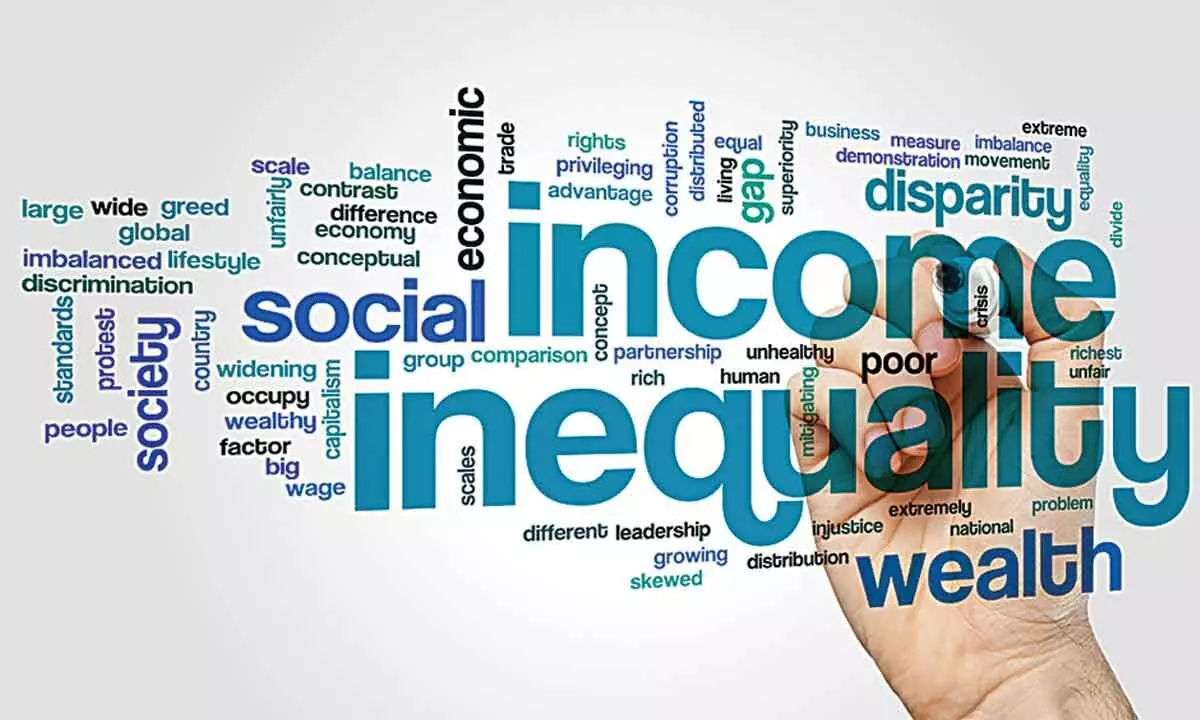Wealth inequality remains India’s bane
The richest one per cent of Indian population owns 53% of the country’s wealth
image for illustrative purpose

By ensuring universal access to public funded high-quality services like public health and education, social security benefits, employment guarantee schemes, inequality can be reduced to a great extent. Promote gender equality in education, employment, and entrepreneurship to empower women economically and socially
Recently, the president of the World Economic Forum (WEF) commended India, foreseeing it as a future $10 trillion economy. However, even as India strengthens its economic position, the advantages of this progress aren't reaching everyone, particularly those who are marginalized.
According to a 2024 UNDP Trends Report, over the past four decades, income inequality has risen within most advanced economies and major emerging economies (equal to two-thirds of the world’s population and 85% of global GDP).
The exclusive emphasis on economic growth is causing increasing concern in India. There is an urgent need for policy interventions and heightened government actions to ensure more inclusive growth.
The growth in real GDP during 2023-24 is estimated at 7.3% as compared to 7.2% in 2022-23. India is ranked fifth in the world's GDP rankings in 2024. The country's economy has been reported to be at $3.7 trillion, marking significant growth from its position as the 10th largest economy a decade ago, with a GDP of $1.9 trillion.
The Indian economy is poised to hit $7.3 trillion by 2030 and $10 trillion mark by 2035 (according to the Centre for Economics and Business Research).
The Union government has set an ambitious target of transforming India into a 'developed country' by 2047.
India is one of the most unequal countries in the world, with the top 10% of the population holding 77% of the total national wealth. The richest one per cent of the Indian population owns 53% of the country’s wealth, while the poorer half jostles for a mere 4.1% of national wealth.
According to the World Inequality Report 2022, India is among the most unequal countries in the world, with the top 10% and top one per cent of the population holding 57% and 22% of the total national income respectively. The share of the bottom 50% has gone down to 13%.
Approximately 64% of the total goods and services tax (GST) in the country came from the bottom 50% of the population, while only four per cent came from the top 10%.
Many ordinary Indians are not able to access the health care they need, while 63 million of them (almost two people every second) are pushed into poverty because of healthcare costs every year.
Around 74% of India’s population could not afford a healthy diet and 39% fell short of a nutrient-adequate one.
Gender Inequality: India was ranked 127 out of 146 countries in the Global Gender Gap Report, 2023, and faces the perennial issue of “missing women” from the workforce – which is a wicked problem.
Concentration of wealth in the hands of a few can perpetuate inequality over generations, as the wealthy can pass on advantages to their descendants.
As per OECD (Organisation for Economic Co-operation and Development), inclusive growth is economic growth that is distributed fairly across society and creates opportunities for all.
It means having access to essential services in health and education by the poor. It includes providing equality of opportunity, empowering people through education and skill development
A one per cent wealth tax on Indian billionaires is enough to fund the National Health Mission, India’s largest healthcare scheme.
Taxing India’s billionaires at two per cent would support the nutrition of India’s malnourished for three years.
There is a need to foster inclusive governance by encouraging citizen participation, promoting transparency, and reducing corruption. Empower local self-governments and involve marginalized communities in decision-making processes.
Engagement: Encourage corporate social responsibility (CSR) initiatives that focus on inclusive development. Encourage private companies to invest in social sectors and support community development projects.
By ensuring universal access to public funded high-quality services like public health and education, social security benefits, employment guarantee schemes, inequality can be reduced to a great extent.
The labour-intensive manufacturing sector has the potential to absorb millions of people who are leaving farming while the service sector tends to benefit the urban middle class.
Promote gender equality in education, employment, and entrepreneurship to empower women economically and socially.
Implement land reforms to address issues of land ownership and tenancy. Ensure fair and equitable distribution of land resources.
Provide a greater voice to traditionally oppressed and suppressed groups, including by enabling civil society groups like unions and associations within these groups.
Technology and Innovation: Embrace technological advancements to create new opportunities for all.
Ensure that the benefits of technological progress are shared across different sections of society. By embracing and implementing inclusive policies that tackle the underlying causes of inequality, India has the potential to transition towards a more equitable society.
This transformative approach aligns with the aspirations of the United Nations' Sustainable Development Goal 10.

